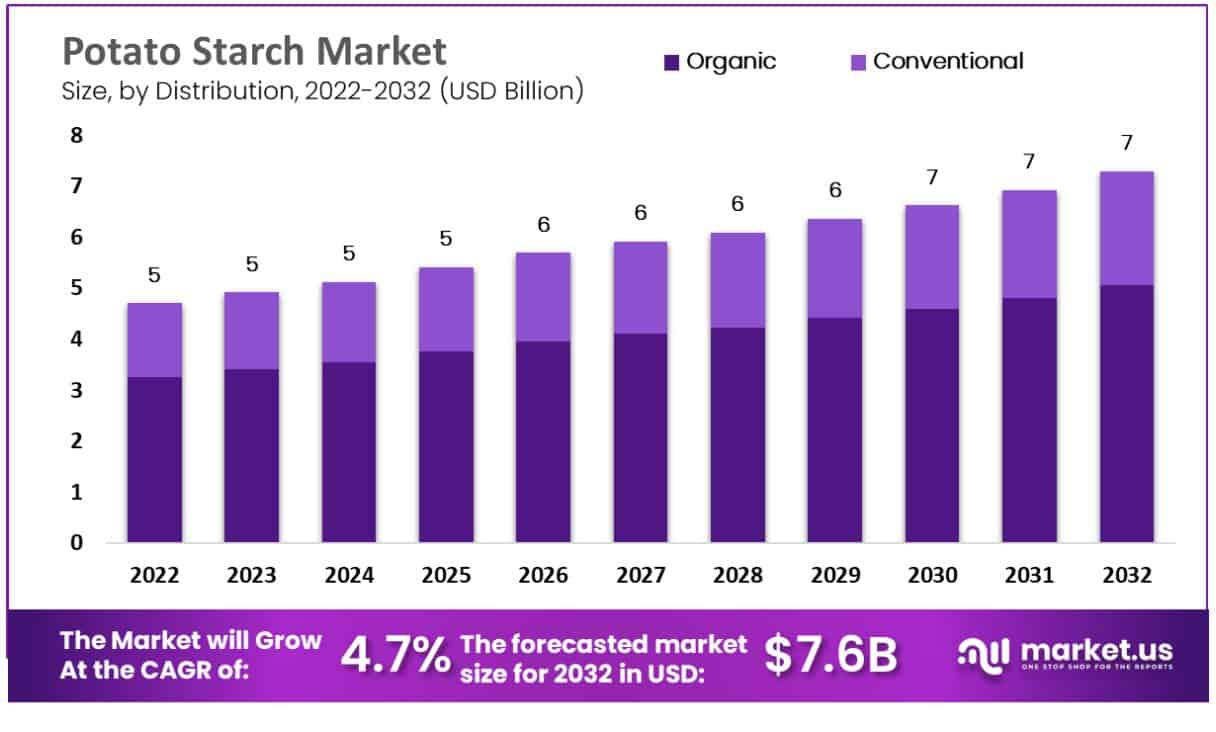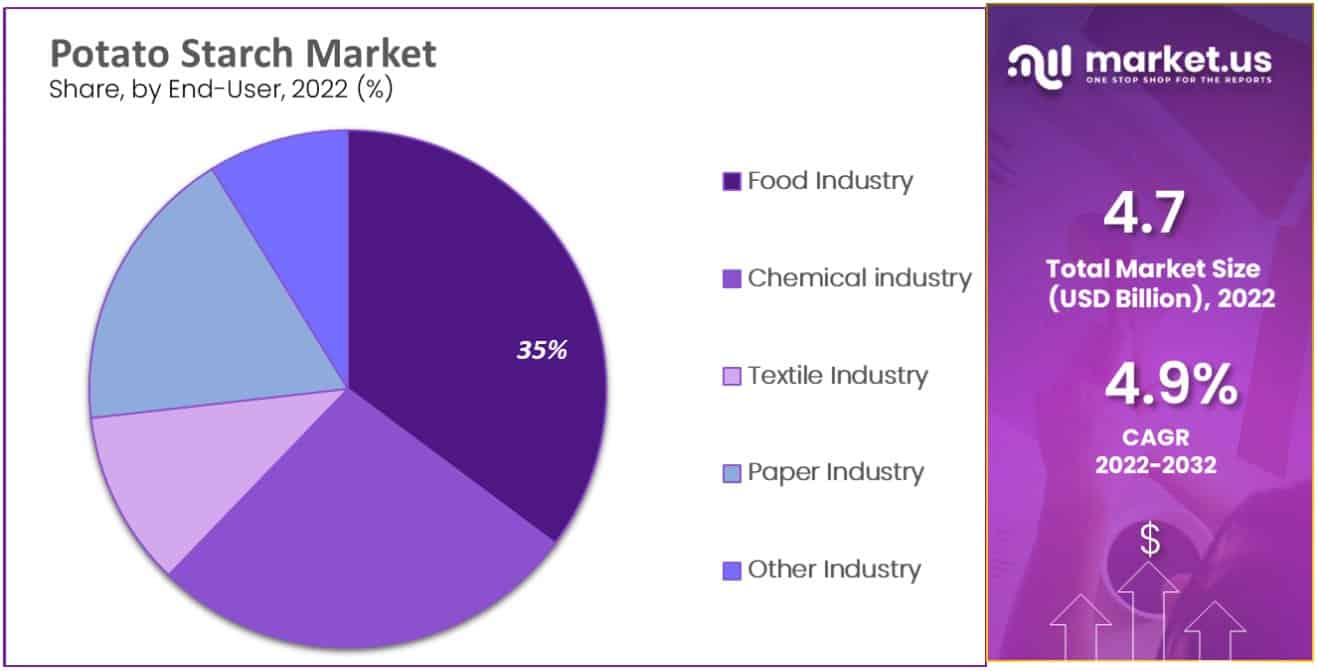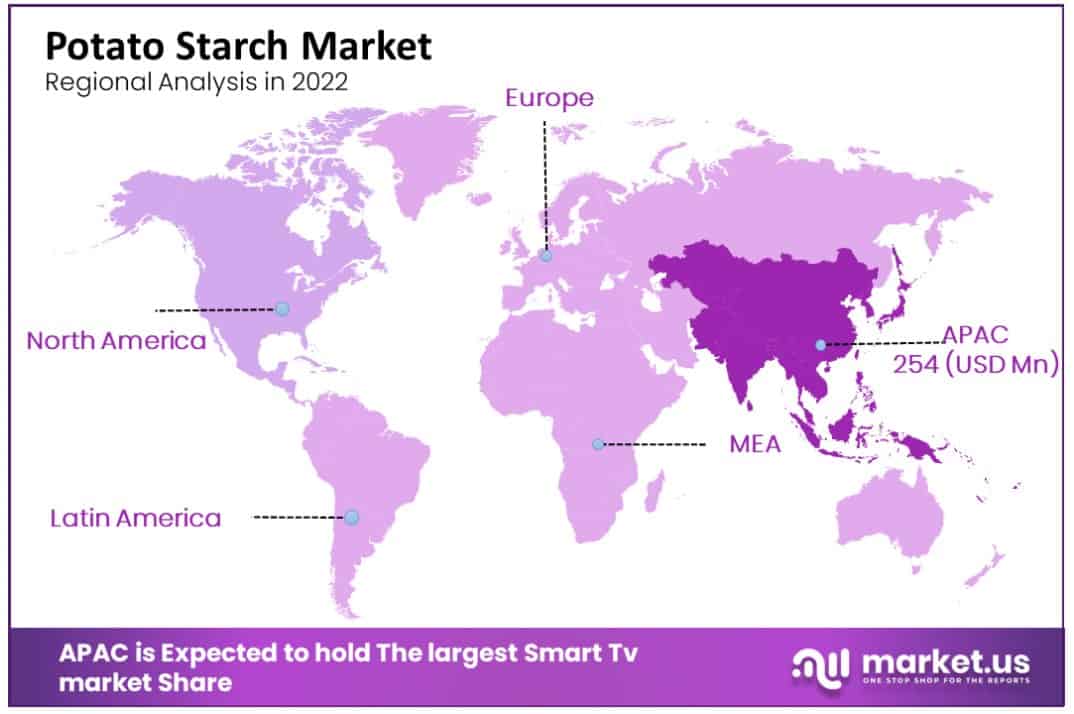Global Potato Starch Market By Type (Native Starch, Modified Starch, and Sweeteners Grade), By Nature, By End User, By Region and Companies - Industry Segment Outlook, Market Assessment, Competition Scenario, Trends, and Forecast 2023-2032
- Published date: Oct 2023
- Report ID: 22882
- Number of Pages: 311
- Format:
- keyboard_arrow_up
Quick Navigation
Report Overview:
In 2022, the global potato starch market was valued at USD 4.7 billion, and is expected to reach USD 7.5 Billion in 2032 Between 2023 and 2032, this market is estimated to register a CAGR of 4.9%.
The clean-label movement has gained popularity in recent years due to the rising desire for safer, healthier, and more natural products. Because they are clean-label, potato starches are becoming more and more popular. The industry is expanding due to the strong demand for inexpensive additives like potato starch.
In addition, potato starch is gaining popularity as a cheap, environmentally friendly alternative to food processors. It is anticipated that as vegetarian meat replacements become more popular, demand for potato starch as a cheap meat substitute will increase.
The potato plant’s root tubers, which have no fat or protein, make potato starch a fine powder. Its special qualities include a neutral flavor, excellent binding power, and little foaming. It provides baked items like muffins and quick bread with a light, fluffy texture.
Consuming it also aids in calcium and magnesium absorption and blood sugar regulation. It has become a popular raw material in the food, paper, textile, and pharmaceutical industries due to its varied qualities.

Key Takeaways
Market Growth: The global Potato Starch Market was valued at USD 4.7 billion in 2022 and is expected to reach USD 7.5 billion by 2032, with an estimated Compound Annual Growth Rate (CAGR) of 4.9% between 2023 and 2032.
Clean-Label Movement: The clean-label movement is driving the popularity of potato starch due to the rising demand for safer, healthier, and more natural products. Potato starch is becoming a preferred choice in the food industry because of its clean-label attributes.
Sustainable and Affordable: Potato starch is gaining popularity as an environmentally friendly and cost-effective alternative in food processing, particularly as a substitute for meat in vegetarian products. Its neutral flavor and binding properties make it an ideal choice for various food applications.
Health Benefits: Potato starch offers health benefits, including aiding in calcium and magnesium absorption and blood sugar regulation. It is being used as a raw material in the food, paper, textile, and pharmaceutical industries due to its unique properties.
Healthy Eating Trend: The healthy eating trend is driving the demand for potato starch, as it is considered a component in functional food and dietary supplements due to its health benefits such as glycemic control and mineral absorption.
Beverage and Confectionery: Potato starch is used as a thickening, binding, and stabilizing agent in the beverage and confectionery industries, contributing to the market’s growth.
Textile Sector Expansion: Potato starch’s use in the textile industry for stiffening and finishing fabrics, as well as in packaging as an adhesive, is driving market growth, particularly in developing nations like China and India.
Carbohydrate Consumption Concerns: Increasing consumer awareness about the health hazards associated with carbohydrate consumption is a significant restraining factor for the market’s growth.
Modified Potato Starch Dominance: In 2022, modified potato starch was the dominant segment in the market due to its increasing use in food and beverages, the paper industry, and pharmaceuticals.
Organic Market Growth: The organic potato starch market is anticipated to experience the highest growth from 2023 to 2032, driven by the demand for clean-label and sustainable food products.
Food Industry Dominance: The food industry is expected to exhibit the highest growth rate, with potato starch being used in a wide variety of food applications, driven by consumer preferences for clean-label and healthy foods.
Innovative Products: Innovative potato starch products are gaining popularity, with companies investing in new products to provide enhanced solutions. For example, Ingredion introduced modified potato starch to enhance potato capabilities and reduce energy consumption in cooking.
Regional Dominance: North America leads the market, driven by demand in the food and beverage sector, followed by the European Union and the Asia Pacific region, with a substantial CAGR predicted.
Key Players: Major key players in the potato starch market include Pepees Group, Cargill Corporation, Emsland Group, and others.
Driving Factors
The Healthy Eating Trend Driving Global Potato Starch Market
A healthy eating trend is gaining traction and eliciting interest, significantly driving healthy food expression. Potato starch is a component in the conformation of functional food & salutary supplements due to its unique applicable parcels and health benefits. It has health benefits similar to glycemic control, control of fasting tube triglyceride and cholesterol situations, and immersion of minerals.
Use of Starch in the Beverage and Confectionery Industries
The global potato starch market is anticipated to be driven by the rising use of starch in the beverage industry and confectionery industries. Additionally, potato starch, a thickening, binding, and stabilizing agent, is a key component in many processed meals. Because clean-label and plant-based products are becoming more and more popular, demand is gradually rising.
Expansion of the Textile Sector Driving the Potato Starch Market
The business is also receiving support for expansion from its growing application in the textile sector. It stiffens and finishes fabrics in the textile industry. The market for potato starch is also benefiting from the expansion of the textile sector generally, particularly in developing nations like China and India. It is generally used for sizing textiles, especially cotton yarns.
Within the sector, it is additionally utilized as an adhesive. Due to a number of advantageous characteristics, including its high viscosity, strong biding ability, and water-holding capacity, it is widely employed in the industry. In addition to other industrial areas, packaging also uses it extensively as an adhesive.
Restraining Factors
Carbohydrate Consumption, a Significant Barrier to the Market’s Expansion
Consumers’ increasing awareness of the health hazards associated with carbohydrate consumption is a significant barrier to this market’s expansion. In the upcoming years, the market’s growth is anticipated to be hampered by the rising use of low-carb diets to preserve general health.
By Type Analysis
Modified Potato Starch Segment Dominate the Market With its Increasing Operation in Various Industries
Based on type, the potato starch market is segmented into modified, native, and sweetener grades. A significant portion of the potato starch market’s profit will be generated by the modified potato starch segment in 2022. The increasing use of modified potatoes in food & beverages, the paper industry, and pharmaceuticals are the crucial factors contributing to the dominant position of this segment.
In food products, native potato starch is utilized for numerous practical purposes. Meat and bakery products, noodles, soups, sauces, snacks & confections, dry mixes, and a variety of extruded food products benefit from its high water-binding capacity. Due to its low protein and fat/lipid content, it gives food a high viscosity and enhances its flavor, aroma, and color. It has good organoleptic properties and can be used as an ingredient in a variety of foods.
By Nature Analysis
Growing Interest in Sustainable And Natural Food is Driving Organic Starch Market
Based on nature potato starch market is segmented into organic and conventional products. During the forecast period from 2023 to 2032, the organic market is anticipated to experience the highest CAGR. The awareness of clean-label products and the growing interest in sustainable & natural food are major factors for this market’s rapid expansion. Organic foods are also seen as safer and healthier because they don’t contain any chemicals or pesticides, which helps this market grow even more.
By End-User Analysis
The need for Potato Starch in a Wide Variety of Food Industry Made the Food Segment Dominant
The food industry sector is expected to exhibit the highest growth rate in the forecast period. As a result of the growing consumer preference for clean-label products and healthy foods, as well as the growing demand for ready-to-eat and ready-to-cook foods, potato starch is used in a wide variety of food industries.
The potato starch market consists of the sales of gravies and soups, sauces, pie fillings, casseroles, and stews. The “factory gate” value in this market refers to the price of items sold by the producers or inventors, whether to other organizations (including wholesalers, downstream manufacturers, retailers, and distributors ) or directly to end users. The value of associated services offered by the producers of the commodities is included in the price of the goods in this market.

Key Market Segments
Based on Type
- Native Starch
- Modified Starch
- Sweetener Grade
Based on Distribution Channel
- Organic
- Conventional
Based on End-User
- Food Industry
- Chemical industry
- Textile Industry
- Paper Industry
- Other Industry
Growth Opportunity
Rising Consumer Demand for Ready-to-eat Food Products Expanding Market
The expanding market for potato starch will be fueled by rising consumer demand for ready-to-eat food products. Ready-to-eat foods are shelf-stable and do not require refrigeration to remain bacteria-free, making them simple to store and use.
Increased consumer willingness to spend money on ready-to-eat food and a lack of time to prepare meals at home as a result of rapid urbanization are the primary factors driving demand for ready-to-eat meals. Most of the time, potato starch is used to thicken canned soups and blends, especially to increase the viscosity of the filling.
Latest Trends
Innovative Products are Gaining Popularity in the Potato Starch Market
In the potato starch market, new innovative products are gaining popularity. In order to provide enhanced solutions for their customers with better qualities, potato starch companies are rapidly investing in new products. In 2021, Ingredion Inc., a supplier of ingredients based in the United States, introduced modified potato starch for use in everyday desserts. Modified potato starch ULTRA-TEX 1311 demonstrates the ingredient’s dedication to enhancing potato capabilities and shortening cooking and processing times, thereby assisting manufacturers in reducing energy consumption.
Regional Analysis
North America is Dominating the Potato Starch Market With Increasing Demand in the Food and Libation Sector
Adding demand from the food and libation sector, North America is dominating the potato starch market. The region’s request is substantially driven by the expanding fashionability of clean-marker and factory-grounded products and because consumers are searching for indulgent yet healthy particulars.
The alternate-largest request share for potato starch is held by the European Union, which is due to the region’s growing interest in organic and factory-grounded food particulars. This incontinently stimulates the indigenous organic starch market’s expansion. A sizable CAGR is prognosticated for the Asia Pacific member as well. The booming food sector in developing nations like China and India is the primary motorist of the region’s need for potato starch.
The region’s food processing assiduity is decreasing in demand for this product due to the rising fashionability of ready-to-eat and ready-to-cook foods. The increased demand for gravies, dressings, bakery goods, and convenience refections is likely to fuel request expansion in the area due to the expanding interest in trying western cookeries.

Key Regions and Countries
- North America
- The US
- Canada
- Mexico
- Western Europe
- Germany
- France
- The UK
- Spain
- Italy
- Portugal
- Ireland
- Austria
- Switzerland
- Benelux
- Nordic
- Rest of Western Europe
- Eastern Europe
- Russia
- Poland
- The Czech Republic
- Greece
- Rest of Eastern Europe
- APAC
- China
- Japan
- South Korea
- India
- Australia & New Zealand
- Indonesia
- Malaysia
- Philippines
- Singapore
- Thailand
- Vietnam
- Rest of APAC
- Latin America
- Brazil
- Colombia
- Chile
- Argentina
- Costa Rica
- Rest of Latin America
- Middle East & Africa
- Algeria
- Egypt
- Israel
- Kuwait
- Nigeria
- Saudi Arabia
- South Africa
- Turkey
- United Arab Emirates
- Rest of MEA
Key Players Analysis
The market has a structure that is somewhat consolidated. Due to their large customer base, strong brand loyalty, and distribution network, a few major players dominate the industry.
Major key players in the potato starch market are Pepees Group, Cargill Corporation, Emsland Group, AGRANA Beteiligungs-AG, Novidon, Sudstarke GmbH, Ingredion, AKV Langholt, Avebe, Tereos, Finnamyl Ltd., Roquette, Manitoba Starch, Aloja Starkelsen SIA, and Tate & Lyle.
Market Key Players
- Pepees Group
- Cargill Corporation
- Emsland Group
- AKV Langholt
- Tate & Lyle
- Agarna Beteiligungs-AG
- Finnamyl Ltd
- Manitoba Starch
- Aloja Starkelsen SIA.
- Other Key Players
Recent Development
- In March 2021, Ingredion Incorporated introduced the new ULTRA-TEX 1311 potato starch line for the US and Canadian markets. It uses the unique properties of waxy potato starch for texturing and thickening in a variety of applications.
- The joint venture Cargill-AKV I/S was acquired by AKV Langholt in October 2022. Cargill’s 50% interest in the mutual joint venture Cargill-AKV I/S has been acquired by AKV Langholt AmbA.
Report Scope
Report Features Description Market Value (2022) US$ 4.7 Bn Forecast Revenue (2032) US$ 7.5 Bn CAGR (2023-2032) 4.9% Base Year for Estimation 2022 Historic Period 2016-2022 Forecast Period 2023-2032 Report Coverage Revenue Forecast, Market Dynamics, COVID-19 Impact, Competitive Landscape, Recent Developments Segments Covered By Type- Native Starch, Modified Starch, and Sweetener Grade; by Nature Organic and Conventional; By end use- Food Industry, Chemical industry, Textile Industry, Paper Industry, and Other Industry Regional Analysis North America – The US, Canada, & Mexico; Western Europe – Germany, France, The UK, Spain, Italy, Portugal, Ireland, Austria, Switzerland, Benelux, Nordic, & Rest of Western Europe; Eastern Europe – Russia, Poland, The Czech Republic, Greece, & Rest of Eastern Europe; APAC – China, Japan, South Korea, India, Australia & New Zealand, Indonesia, Malaysia, Philippines, Singapore, Thailand, Vietnam, & Rest of APAC; Latin America – Brazil, Colombia, Chile, Argentina, Costa Rica, & Rest of Latin America; the Middle East & Africa – Algeria, Egypt, Israel, Kuwait, Nigeria, Saudi Arabia, South Africa, Turkey, United Arab Emirates, & Rest of MEA Competitive Landscape Pepees Group, Cargill Corporation, Emsland Group, AKV Langholt, Tate & Lyle, Agarna Beteiligungs-AG, Finnamyl Ltd, Manitoba Starch, Aloja Starkelsen SIA, and Other Key Players Customization Scope Customization for segments, region/country-level will be provided. Moreover, additional customization can be done based on the requirements. Purchase Options We have three licenses to opt for: Single User License, Multi-User License (Up to 5 Users), Corporate Use License (Unlimited User and Printable PDF) Frequently Asked Questions (FAQ)
What is the value of the global potato starch Market?In 2022, the global potato starch market was valued at USD 4.7 billion, and is expected to reach USD 7.5 Billion in 2032 Between 2023 and 2032
What CAGR is projected for the potato starch Market?The potato starch Market is expected to grow at 4.9%. CAGR (2023-2032).
Name the major industry players in the potato starch Market.Pepees Group, Cargill Corporation, Emsland Group, AKV Langholt, Tate & Lyle, Agarna Beteiligungs-AG, Finnamyl Ltd, Manitoba Starch, Aloja Starkelsen SIA., Other Key Players

- Pepees Group
- Cargill Corporation
- Emsland Group
- AKV Langholt
- Tate & Lyle
- Agarna Beteiligungs-AG
- Finnamyl Ltd
- Manitoba Starch
- Aloja Starkelsen SIA.
- Other Key Players
- settingsSettings
Our Clients
| Single User $4,599 $3,499 USD / per unit save 24% | Multi User $5,999 $4,299 USD / per unit save 28% | Corporate User $7,299 $4,999 USD / per unit save 32% | |
|---|---|---|---|
| e-Access | |||
| Report Library Access | |||
| Data Set (Excel) | |||
| Company Profile Library Access | |||
| Interactive Dashboard | |||
| Free Custumization | No | up to 10 hrs work | up to 30 hrs work |
| Accessibility | 1 User | 2-5 User | Unlimited |
| Analyst Support | up to 20 hrs | up to 40 hrs | up to 50 hrs |
| Benefit | Up to 20% off on next purchase | Up to 25% off on next purchase | Up to 30% off on next purchase |
| Buy Now ($ 3,499) | Buy Now ($ 4,299) | Buy Now ($ 4,999) |












